Critically Evaluating the Effects of a Changing Business Environment
VerifiedAdded on 2023/04/23
|9
|2176
|277
Essay
AI Summary
This essay critically evaluates how a changing business environment affects perceptions of fairness and justice associated with the employment relationship. It explores the concept of resistance to change, its causes, and its impact on employee attitudes and organizational performance. The essay discusses how changes in the business environment, such as new technologies, economic shifts, and legal requirements, necessitate adjustments in employment policies. It emphasizes the importance of fairness and justice in maintaining strong employment relationships and highlights the role of organizational justice, information quality, and interpersonal treatment in shaping employee perceptions. The essay concludes that businesses must adapt their strategic plans to keep up with changes while maintaining equity, fairness, and justice to foster a positive and productive work environment. Desklib offers a platform for students to access this essay and other solved assignments to aid in their studies.
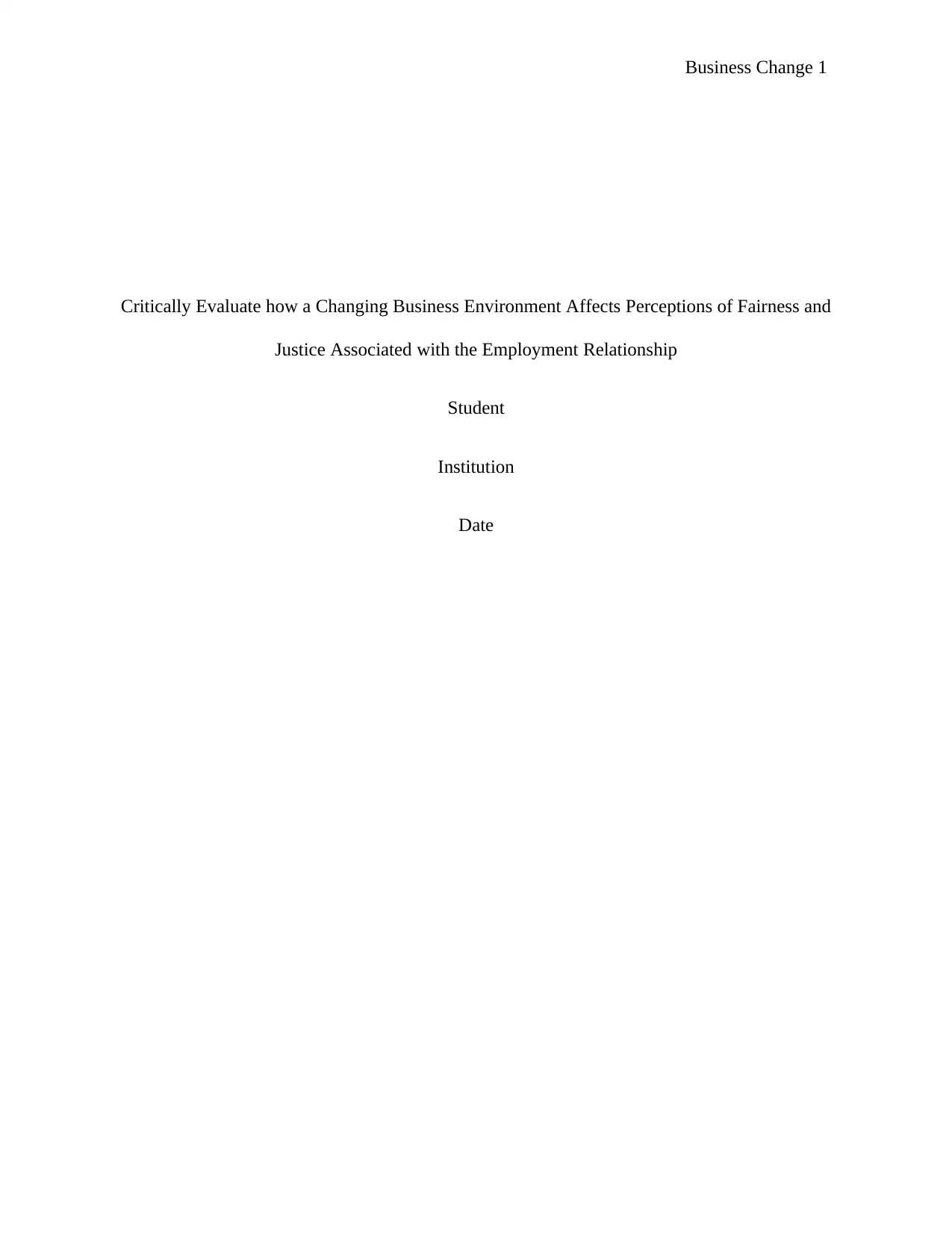
Business Change 1
Critically Evaluate how a Changing Business Environment Affects Perceptions of Fairness and
Justice Associated with the Employment Relationship
Student
Institution
Date
Critically Evaluate how a Changing Business Environment Affects Perceptions of Fairness and
Justice Associated with the Employment Relationship
Student
Institution
Date
Paraphrase This Document
Need a fresh take? Get an instant paraphrase of this document with our AI Paraphraser
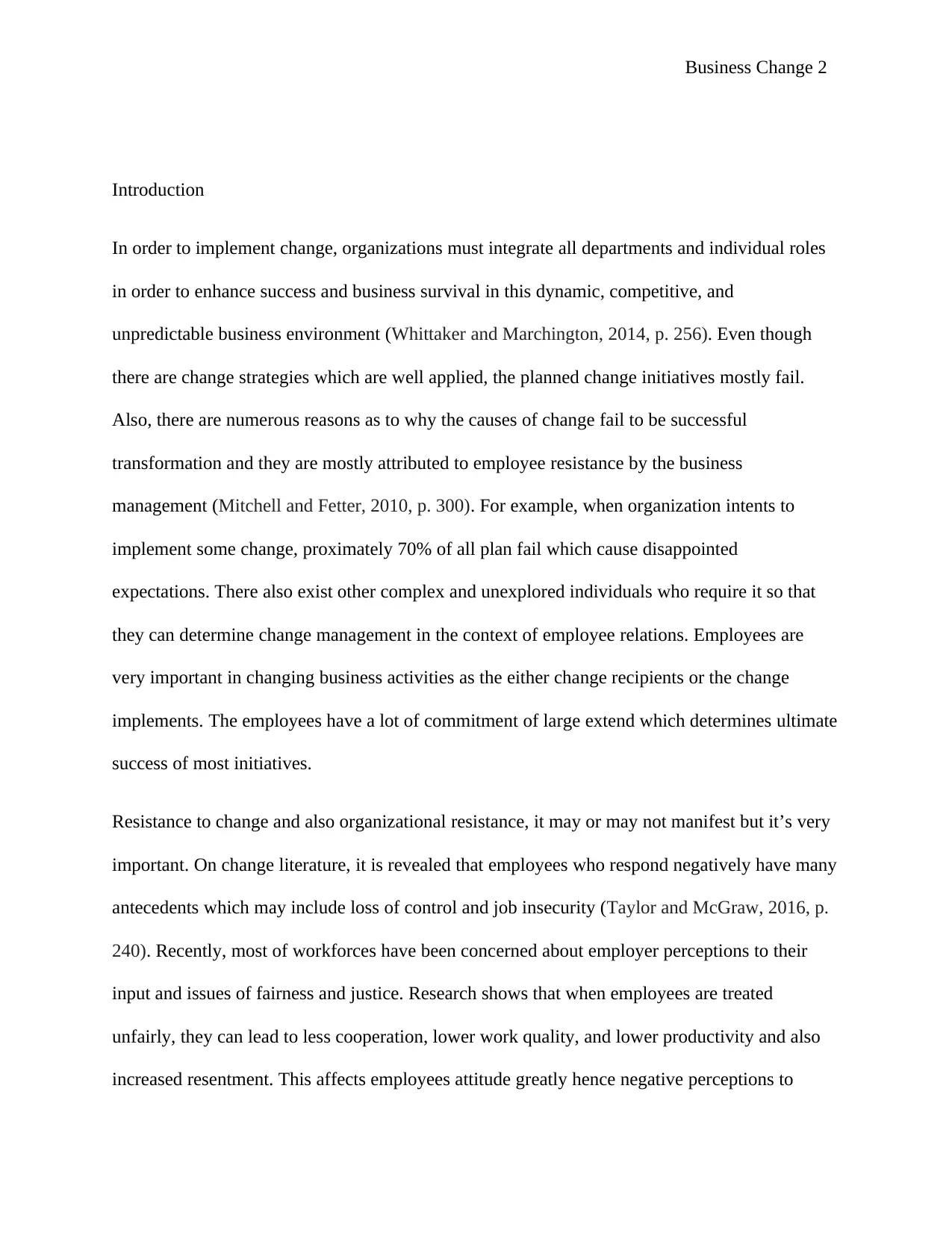
Business Change 2
Introduction
In order to implement change, organizations must integrate all departments and individual roles
in order to enhance success and business survival in this dynamic, competitive, and
unpredictable business environment (Whittaker and Marchington, 2014, p. 256). Even though
there are change strategies which are well applied, the planned change initiatives mostly fail.
Also, there are numerous reasons as to why the causes of change fail to be successful
transformation and they are mostly attributed to employee resistance by the business
management (Mitchell and Fetter, 2010, p. 300). For example, when organization intents to
implement some change, proximately 70% of all plan fail which cause disappointed
expectations. There also exist other complex and unexplored individuals who require it so that
they can determine change management in the context of employee relations. Employees are
very important in changing business activities as the either change recipients or the change
implements. The employees have a lot of commitment of large extend which determines ultimate
success of most initiatives.
Resistance to change and also organizational resistance, it may or may not manifest but it’s very
important. On change literature, it is revealed that employees who respond negatively have many
antecedents which may include loss of control and job insecurity (Taylor and McGraw, 2016, p.
240). Recently, most of workforces have been concerned about employer perceptions to their
input and issues of fairness and justice. Research shows that when employees are treated
unfairly, they can lead to less cooperation, lower work quality, and lower productivity and also
increased resentment. This affects employees attitude greatly hence negative perceptions to
Introduction
In order to implement change, organizations must integrate all departments and individual roles
in order to enhance success and business survival in this dynamic, competitive, and
unpredictable business environment (Whittaker and Marchington, 2014, p. 256). Even though
there are change strategies which are well applied, the planned change initiatives mostly fail.
Also, there are numerous reasons as to why the causes of change fail to be successful
transformation and they are mostly attributed to employee resistance by the business
management (Mitchell and Fetter, 2010, p. 300). For example, when organization intents to
implement some change, proximately 70% of all plan fail which cause disappointed
expectations. There also exist other complex and unexplored individuals who require it so that
they can determine change management in the context of employee relations. Employees are
very important in changing business activities as the either change recipients or the change
implements. The employees have a lot of commitment of large extend which determines ultimate
success of most initiatives.
Resistance to change and also organizational resistance, it may or may not manifest but it’s very
important. On change literature, it is revealed that employees who respond negatively have many
antecedents which may include loss of control and job insecurity (Taylor and McGraw, 2016, p.
240). Recently, most of workforces have been concerned about employer perceptions to their
input and issues of fairness and justice. Research shows that when employees are treated
unfairly, they can lead to less cooperation, lower work quality, and lower productivity and also
increased resentment. This affects employees attitude greatly hence negative perceptions to
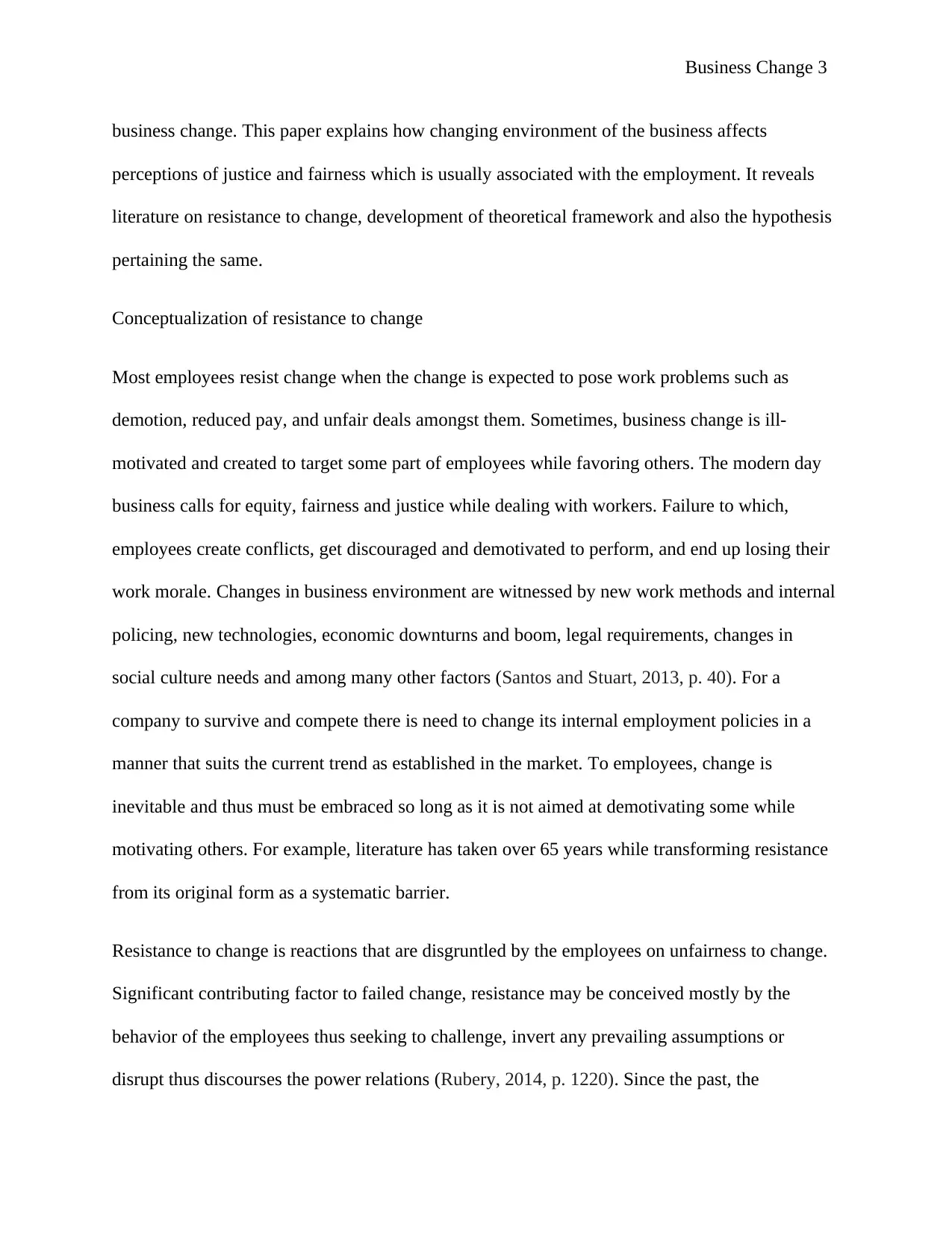
Business Change 3
business change. This paper explains how changing environment of the business affects
perceptions of justice and fairness which is usually associated with the employment. It reveals
literature on resistance to change, development of theoretical framework and also the hypothesis
pertaining the same.
Conceptualization of resistance to change
Most employees resist change when the change is expected to pose work problems such as
demotion, reduced pay, and unfair deals amongst them. Sometimes, business change is ill-
motivated and created to target some part of employees while favoring others. The modern day
business calls for equity, fairness and justice while dealing with workers. Failure to which,
employees create conflicts, get discouraged and demotivated to perform, and end up losing their
work morale. Changes in business environment are witnessed by new work methods and internal
policing, new technologies, economic downturns and boom, legal requirements, changes in
social culture needs and among many other factors (Santos and Stuart, 2013, p. 40). For a
company to survive and compete there is need to change its internal employment policies in a
manner that suits the current trend as established in the market. To employees, change is
inevitable and thus must be embraced so long as it is not aimed at demotivating some while
motivating others. For example, literature has taken over 65 years while transforming resistance
from its original form as a systematic barrier.
Resistance to change is reactions that are disgruntled by the employees on unfairness to change.
Significant contributing factor to failed change, resistance may be conceived mostly by the
behavior of the employees thus seeking to challenge, invert any prevailing assumptions or
disrupt thus discourses the power relations (Rubery, 2014, p. 1220). Since the past, the
business change. This paper explains how changing environment of the business affects
perceptions of justice and fairness which is usually associated with the employment. It reveals
literature on resistance to change, development of theoretical framework and also the hypothesis
pertaining the same.
Conceptualization of resistance to change
Most employees resist change when the change is expected to pose work problems such as
demotion, reduced pay, and unfair deals amongst them. Sometimes, business change is ill-
motivated and created to target some part of employees while favoring others. The modern day
business calls for equity, fairness and justice while dealing with workers. Failure to which,
employees create conflicts, get discouraged and demotivated to perform, and end up losing their
work morale. Changes in business environment are witnessed by new work methods and internal
policing, new technologies, economic downturns and boom, legal requirements, changes in
social culture needs and among many other factors (Santos and Stuart, 2013, p. 40). For a
company to survive and compete there is need to change its internal employment policies in a
manner that suits the current trend as established in the market. To employees, change is
inevitable and thus must be embraced so long as it is not aimed at demotivating some while
motivating others. For example, literature has taken over 65 years while transforming resistance
from its original form as a systematic barrier.
Resistance to change is reactions that are disgruntled by the employees on unfairness to change.
Significant contributing factor to failed change, resistance may be conceived mostly by the
behavior of the employees thus seeking to challenge, invert any prevailing assumptions or
disrupt thus discourses the power relations (Rubery, 2014, p. 1220). Since the past, the
⊘ This is a preview!⊘
Do you want full access?
Subscribe today to unlock all pages.

Trusted by 1+ million students worldwide
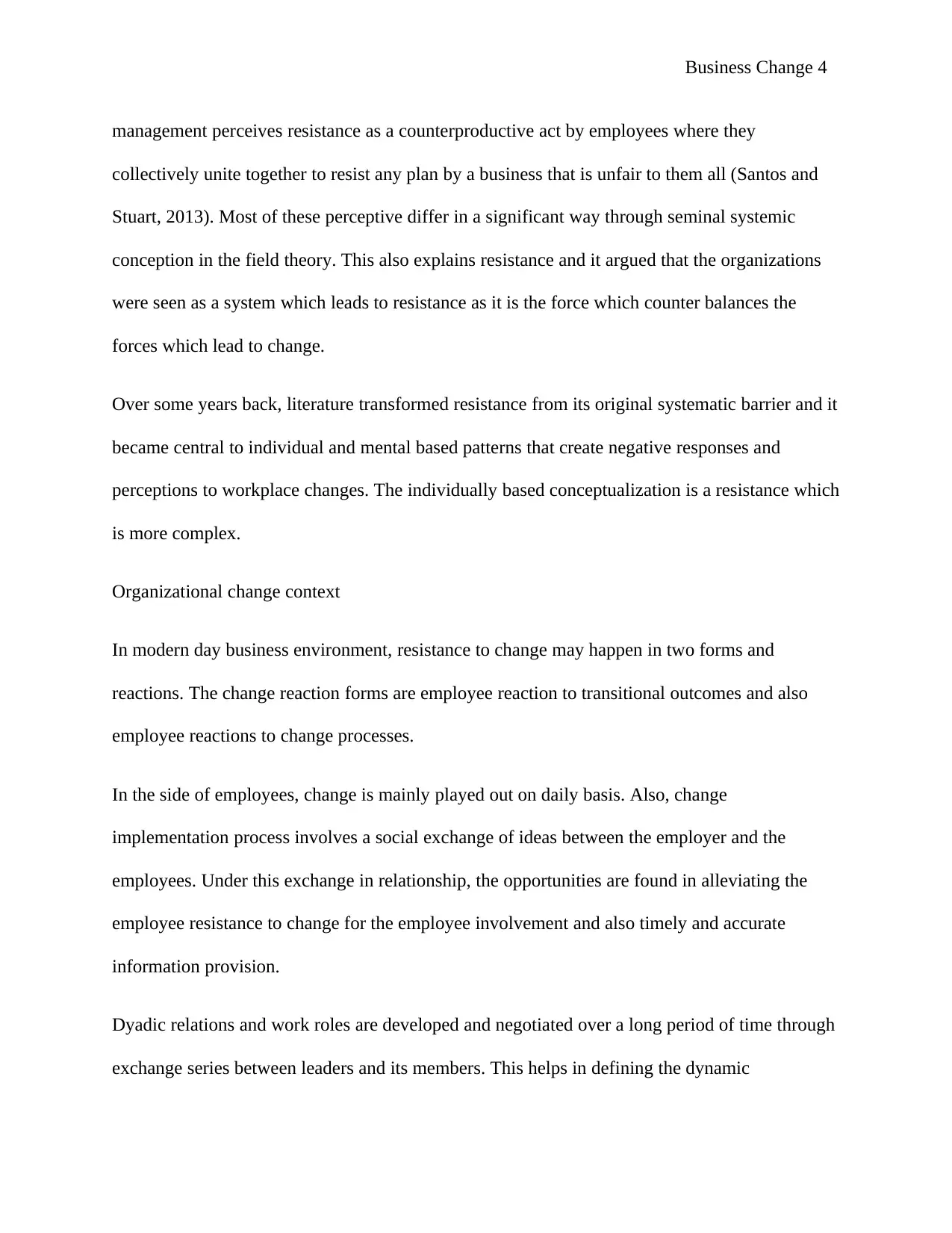
Business Change 4
management perceives resistance as a counterproductive act by employees where they
collectively unite together to resist any plan by a business that is unfair to them all (Santos and
Stuart, 2013). Most of these perceptive differ in a significant way through seminal systemic
conception in the field theory. This also explains resistance and it argued that the organizations
were seen as a system which leads to resistance as it is the force which counter balances the
forces which lead to change.
Over some years back, literature transformed resistance from its original systematic barrier and it
became central to individual and mental based patterns that create negative responses and
perceptions to workplace changes. The individually based conceptualization is a resistance which
is more complex.
Organizational change context
In modern day business environment, resistance to change may happen in two forms and
reactions. The change reaction forms are employee reaction to transitional outcomes and also
employee reactions to change processes.
In the side of employees, change is mainly played out on daily basis. Also, change
implementation process involves a social exchange of ideas between the employer and the
employees. Under this exchange in relationship, the opportunities are found in alleviating the
employee resistance to change for the employee involvement and also timely and accurate
information provision.
Dyadic relations and work roles are developed and negotiated over a long period of time through
exchange series between leaders and its members. This helps in defining the dynamic
management perceives resistance as a counterproductive act by employees where they
collectively unite together to resist any plan by a business that is unfair to them all (Santos and
Stuart, 2013). Most of these perceptive differ in a significant way through seminal systemic
conception in the field theory. This also explains resistance and it argued that the organizations
were seen as a system which leads to resistance as it is the force which counter balances the
forces which lead to change.
Over some years back, literature transformed resistance from its original systematic barrier and it
became central to individual and mental based patterns that create negative responses and
perceptions to workplace changes. The individually based conceptualization is a resistance which
is more complex.
Organizational change context
In modern day business environment, resistance to change may happen in two forms and
reactions. The change reaction forms are employee reaction to transitional outcomes and also
employee reactions to change processes.
In the side of employees, change is mainly played out on daily basis. Also, change
implementation process involves a social exchange of ideas between the employer and the
employees. Under this exchange in relationship, the opportunities are found in alleviating the
employee resistance to change for the employee involvement and also timely and accurate
information provision.
Dyadic relations and work roles are developed and negotiated over a long period of time through
exchange series between leaders and its members. This helps in defining the dynamic
Paraphrase This Document
Need a fresh take? Get an instant paraphrase of this document with our AI Paraphraser
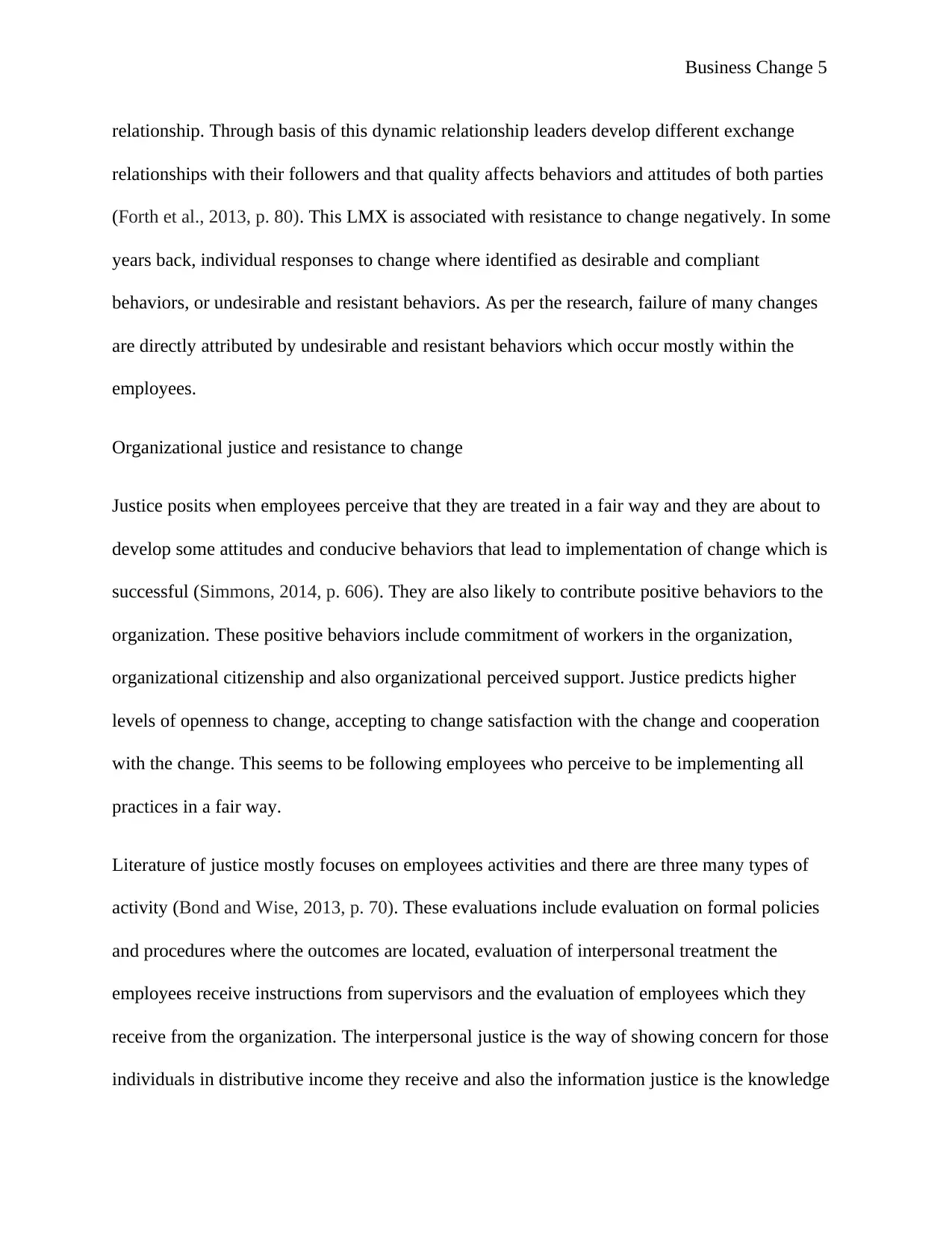
Business Change 5
relationship. Through basis of this dynamic relationship leaders develop different exchange
relationships with their followers and that quality affects behaviors and attitudes of both parties
(Forth et al., 2013, p. 80). This LMX is associated with resistance to change negatively. In some
years back, individual responses to change where identified as desirable and compliant
behaviors, or undesirable and resistant behaviors. As per the research, failure of many changes
are directly attributed by undesirable and resistant behaviors which occur mostly within the
employees.
Organizational justice and resistance to change
Justice posits when employees perceive that they are treated in a fair way and they are about to
develop some attitudes and conducive behaviors that lead to implementation of change which is
successful (Simmons, 2014, p. 606). They are also likely to contribute positive behaviors to the
organization. These positive behaviors include commitment of workers in the organization,
organizational citizenship and also organizational perceived support. Justice predicts higher
levels of openness to change, accepting to change satisfaction with the change and cooperation
with the change. This seems to be following employees who perceive to be implementing all
practices in a fair way.
Literature of justice mostly focuses on employees activities and there are three many types of
activity (Bond and Wise, 2013, p. 70). These evaluations include evaluation on formal policies
and procedures where the outcomes are located, evaluation of interpersonal treatment the
employees receive instructions from supervisors and the evaluation of employees which they
receive from the organization. The interpersonal justice is the way of showing concern for those
individuals in distributive income they receive and also the information justice is the knowledge
relationship. Through basis of this dynamic relationship leaders develop different exchange
relationships with their followers and that quality affects behaviors and attitudes of both parties
(Forth et al., 2013, p. 80). This LMX is associated with resistance to change negatively. In some
years back, individual responses to change where identified as desirable and compliant
behaviors, or undesirable and resistant behaviors. As per the research, failure of many changes
are directly attributed by undesirable and resistant behaviors which occur mostly within the
employees.
Organizational justice and resistance to change
Justice posits when employees perceive that they are treated in a fair way and they are about to
develop some attitudes and conducive behaviors that lead to implementation of change which is
successful (Simmons, 2014, p. 606). They are also likely to contribute positive behaviors to the
organization. These positive behaviors include commitment of workers in the organization,
organizational citizenship and also organizational perceived support. Justice predicts higher
levels of openness to change, accepting to change satisfaction with the change and cooperation
with the change. This seems to be following employees who perceive to be implementing all
practices in a fair way.
Literature of justice mostly focuses on employees activities and there are three many types of
activity (Bond and Wise, 2013, p. 70). These evaluations include evaluation on formal policies
and procedures where the outcomes are located, evaluation of interpersonal treatment the
employees receive instructions from supervisors and the evaluation of employees which they
receive from the organization. The interpersonal justice is the way of showing concern for those
individuals in distributive income they receive and also the information justice is the knowledge
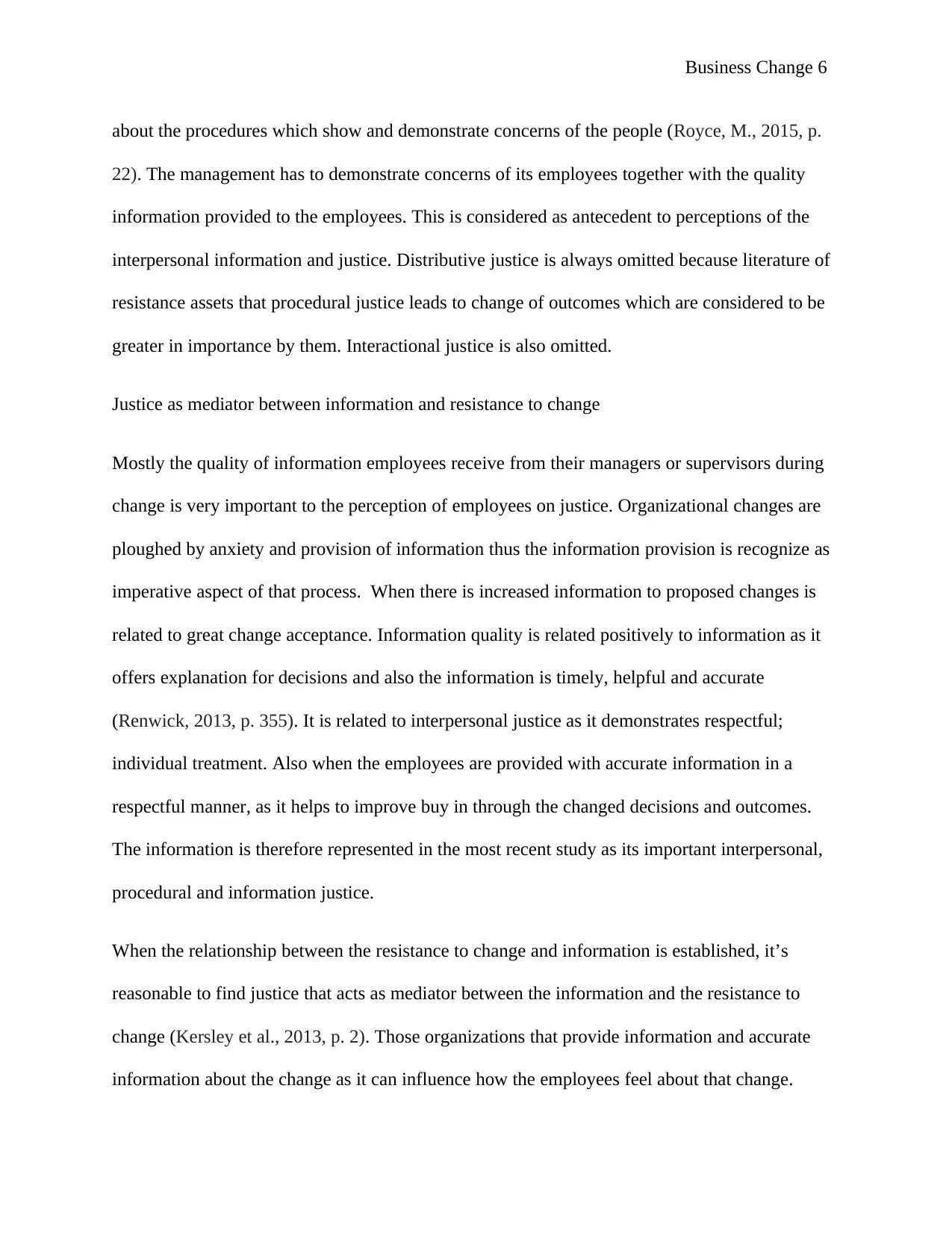
Business Change 6
about the procedures which show and demonstrate concerns of the people (Royce, M., 2015, p.
22). The management has to demonstrate concerns of its employees together with the quality
information provided to the employees. This is considered as antecedent to perceptions of the
interpersonal information and justice. Distributive justice is always omitted because literature of
resistance assets that procedural justice leads to change of outcomes which are considered to be
greater in importance by them. Interactional justice is also omitted.
Justice as mediator between information and resistance to change
Mostly the quality of information employees receive from their managers or supervisors during
change is very important to the perception of employees on justice. Organizational changes are
ploughed by anxiety and provision of information thus the information provision is recognize as
imperative aspect of that process. When there is increased information to proposed changes is
related to great change acceptance. Information quality is related positively to information as it
offers explanation for decisions and also the information is timely, helpful and accurate
(Renwick, 2013, p. 355). It is related to interpersonal justice as it demonstrates respectful;
individual treatment. Also when the employees are provided with accurate information in a
respectful manner, as it helps to improve buy in through the changed decisions and outcomes.
The information is therefore represented in the most recent study as its important interpersonal,
procedural and information justice.
When the relationship between the resistance to change and information is established, it’s
reasonable to find justice that acts as mediator between the information and the resistance to
change (Kersley et al., 2013, p. 2). Those organizations that provide information and accurate
information about the change as it can influence how the employees feel about that change.
about the procedures which show and demonstrate concerns of the people (Royce, M., 2015, p.
22). The management has to demonstrate concerns of its employees together with the quality
information provided to the employees. This is considered as antecedent to perceptions of the
interpersonal information and justice. Distributive justice is always omitted because literature of
resistance assets that procedural justice leads to change of outcomes which are considered to be
greater in importance by them. Interactional justice is also omitted.
Justice as mediator between information and resistance to change
Mostly the quality of information employees receive from their managers or supervisors during
change is very important to the perception of employees on justice. Organizational changes are
ploughed by anxiety and provision of information thus the information provision is recognize as
imperative aspect of that process. When there is increased information to proposed changes is
related to great change acceptance. Information quality is related positively to information as it
offers explanation for decisions and also the information is timely, helpful and accurate
(Renwick, 2013, p. 355). It is related to interpersonal justice as it demonstrates respectful;
individual treatment. Also when the employees are provided with accurate information in a
respectful manner, as it helps to improve buy in through the changed decisions and outcomes.
The information is therefore represented in the most recent study as its important interpersonal,
procedural and information justice.
When the relationship between the resistance to change and information is established, it’s
reasonable to find justice that acts as mediator between the information and the resistance to
change (Kersley et al., 2013, p. 2). Those organizations that provide information and accurate
information about the change as it can influence how the employees feel about that change.
⊘ This is a preview!⊘
Do you want full access?
Subscribe today to unlock all pages.

Trusted by 1+ million students worldwide
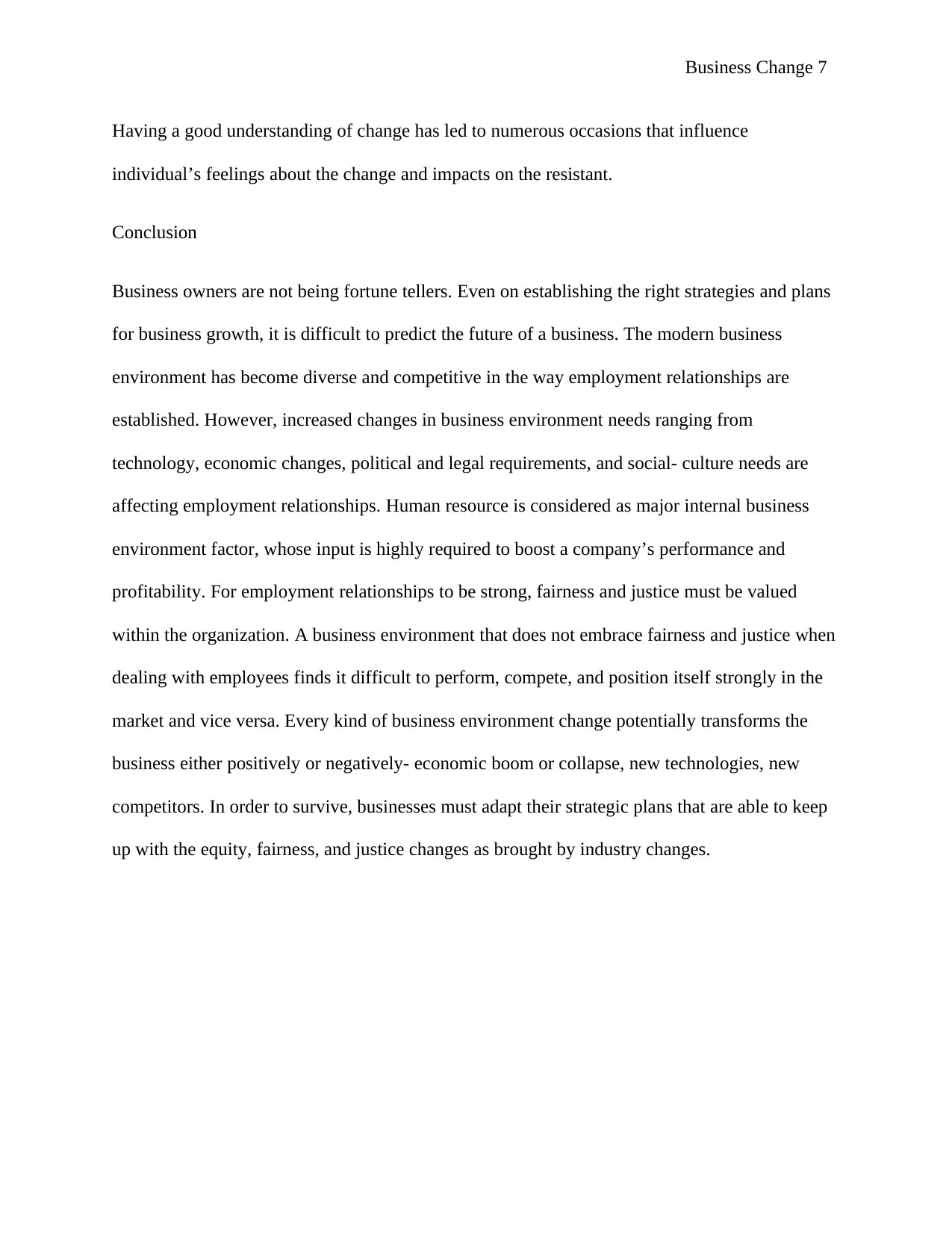
Business Change 7
Having a good understanding of change has led to numerous occasions that influence
individual’s feelings about the change and impacts on the resistant.
Conclusion
Business owners are not being fortune tellers. Even on establishing the right strategies and plans
for business growth, it is difficult to predict the future of a business. The modern business
environment has become diverse and competitive in the way employment relationships are
established. However, increased changes in business environment needs ranging from
technology, economic changes, political and legal requirements, and social- culture needs are
affecting employment relationships. Human resource is considered as major internal business
environment factor, whose input is highly required to boost a company’s performance and
profitability. For employment relationships to be strong, fairness and justice must be valued
within the organization. A business environment that does not embrace fairness and justice when
dealing with employees finds it difficult to perform, compete, and position itself strongly in the
market and vice versa. Every kind of business environment change potentially transforms the
business either positively or negatively- economic boom or collapse, new technologies, new
competitors. In order to survive, businesses must adapt their strategic plans that are able to keep
up with the equity, fairness, and justice changes as brought by industry changes.
Having a good understanding of change has led to numerous occasions that influence
individual’s feelings about the change and impacts on the resistant.
Conclusion
Business owners are not being fortune tellers. Even on establishing the right strategies and plans
for business growth, it is difficult to predict the future of a business. The modern business
environment has become diverse and competitive in the way employment relationships are
established. However, increased changes in business environment needs ranging from
technology, economic changes, political and legal requirements, and social- culture needs are
affecting employment relationships. Human resource is considered as major internal business
environment factor, whose input is highly required to boost a company’s performance and
profitability. For employment relationships to be strong, fairness and justice must be valued
within the organization. A business environment that does not embrace fairness and justice when
dealing with employees finds it difficult to perform, compete, and position itself strongly in the
market and vice versa. Every kind of business environment change potentially transforms the
business either positively or negatively- economic boom or collapse, new technologies, new
competitors. In order to survive, businesses must adapt their strategic plans that are able to keep
up with the equity, fairness, and justice changes as brought by industry changes.
Paraphrase This Document
Need a fresh take? Get an instant paraphrase of this document with our AI Paraphraser
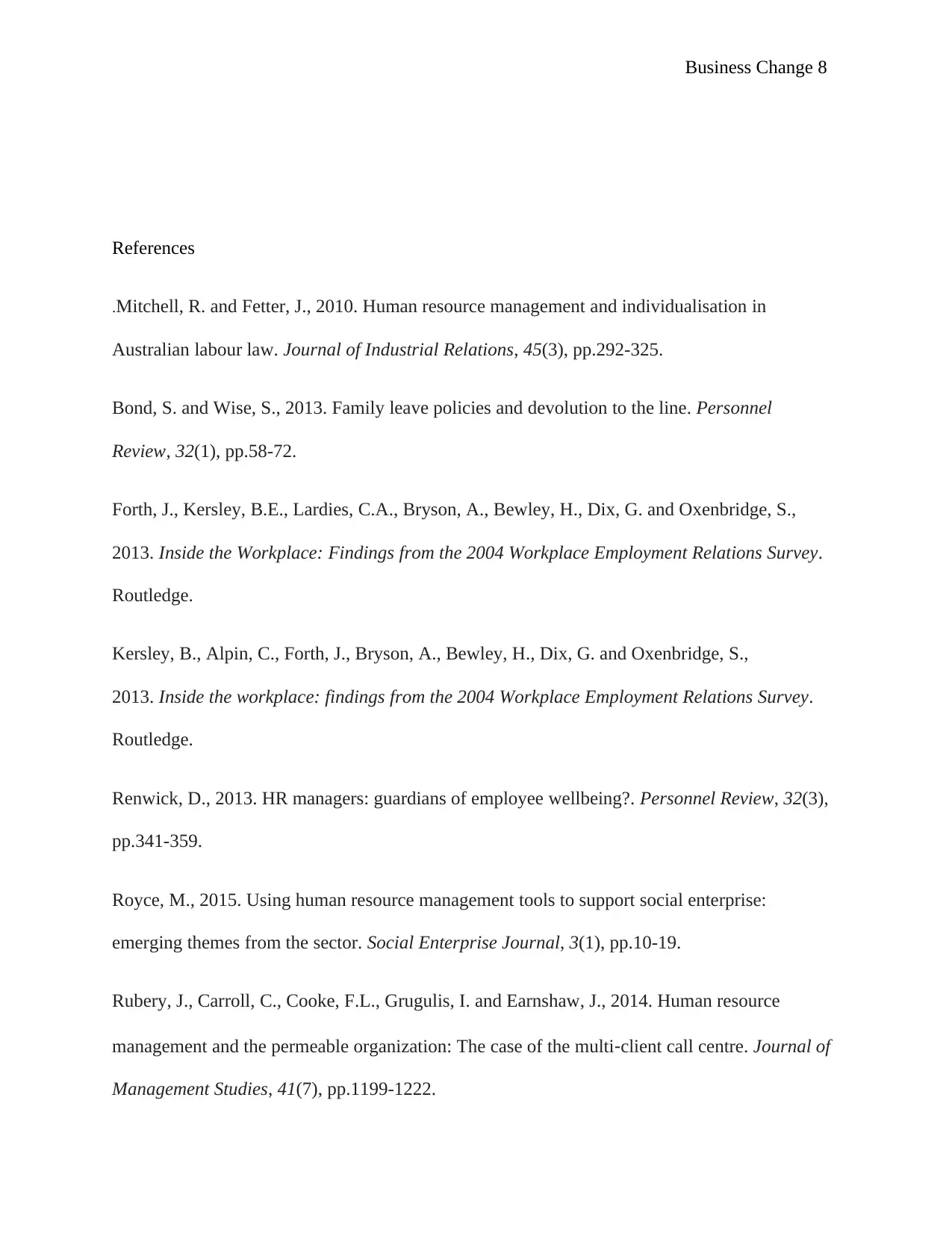
Business Change 8
References
.Mitchell, R. and Fetter, J., 2010. Human resource management and individualisation in
Australian labour law. Journal of Industrial Relations, 45(3), pp.292-325.
Bond, S. and Wise, S., 2013. Family leave policies and devolution to the line. Personnel
Review, 32(1), pp.58-72.
Forth, J., Kersley, B.E., Lardies, C.A., Bryson, A., Bewley, H., Dix, G. and Oxenbridge, S.,
2013. Inside the Workplace: Findings from the 2004 Workplace Employment Relations Survey.
Routledge.
Kersley, B., Alpin, C., Forth, J., Bryson, A., Bewley, H., Dix, G. and Oxenbridge, S.,
2013. Inside the workplace: findings from the 2004 Workplace Employment Relations Survey.
Routledge.
Renwick, D., 2013. HR managers: guardians of employee wellbeing?. Personnel Review, 32(3),
pp.341-359.
Royce, M., 2015. Using human resource management tools to support social enterprise:
emerging themes from the sector. Social Enterprise Journal, 3(1), pp.10-19.
Rubery, J., Carroll, C., Cooke, F.L., Grugulis, I. and Earnshaw, J., 2014. Human resource
management and the permeable organization: The case of the multi‐client call centre. Journal of
Management Studies, 41(7), pp.1199-1222.
References
.Mitchell, R. and Fetter, J., 2010. Human resource management and individualisation in
Australian labour law. Journal of Industrial Relations, 45(3), pp.292-325.
Bond, S. and Wise, S., 2013. Family leave policies and devolution to the line. Personnel
Review, 32(1), pp.58-72.
Forth, J., Kersley, B.E., Lardies, C.A., Bryson, A., Bewley, H., Dix, G. and Oxenbridge, S.,
2013. Inside the Workplace: Findings from the 2004 Workplace Employment Relations Survey.
Routledge.
Kersley, B., Alpin, C., Forth, J., Bryson, A., Bewley, H., Dix, G. and Oxenbridge, S.,
2013. Inside the workplace: findings from the 2004 Workplace Employment Relations Survey.
Routledge.
Renwick, D., 2013. HR managers: guardians of employee wellbeing?. Personnel Review, 32(3),
pp.341-359.
Royce, M., 2015. Using human resource management tools to support social enterprise:
emerging themes from the sector. Social Enterprise Journal, 3(1), pp.10-19.
Rubery, J., Carroll, C., Cooke, F.L., Grugulis, I. and Earnshaw, J., 2014. Human resource
management and the permeable organization: The case of the multi‐client call centre. Journal of
Management Studies, 41(7), pp.1199-1222.
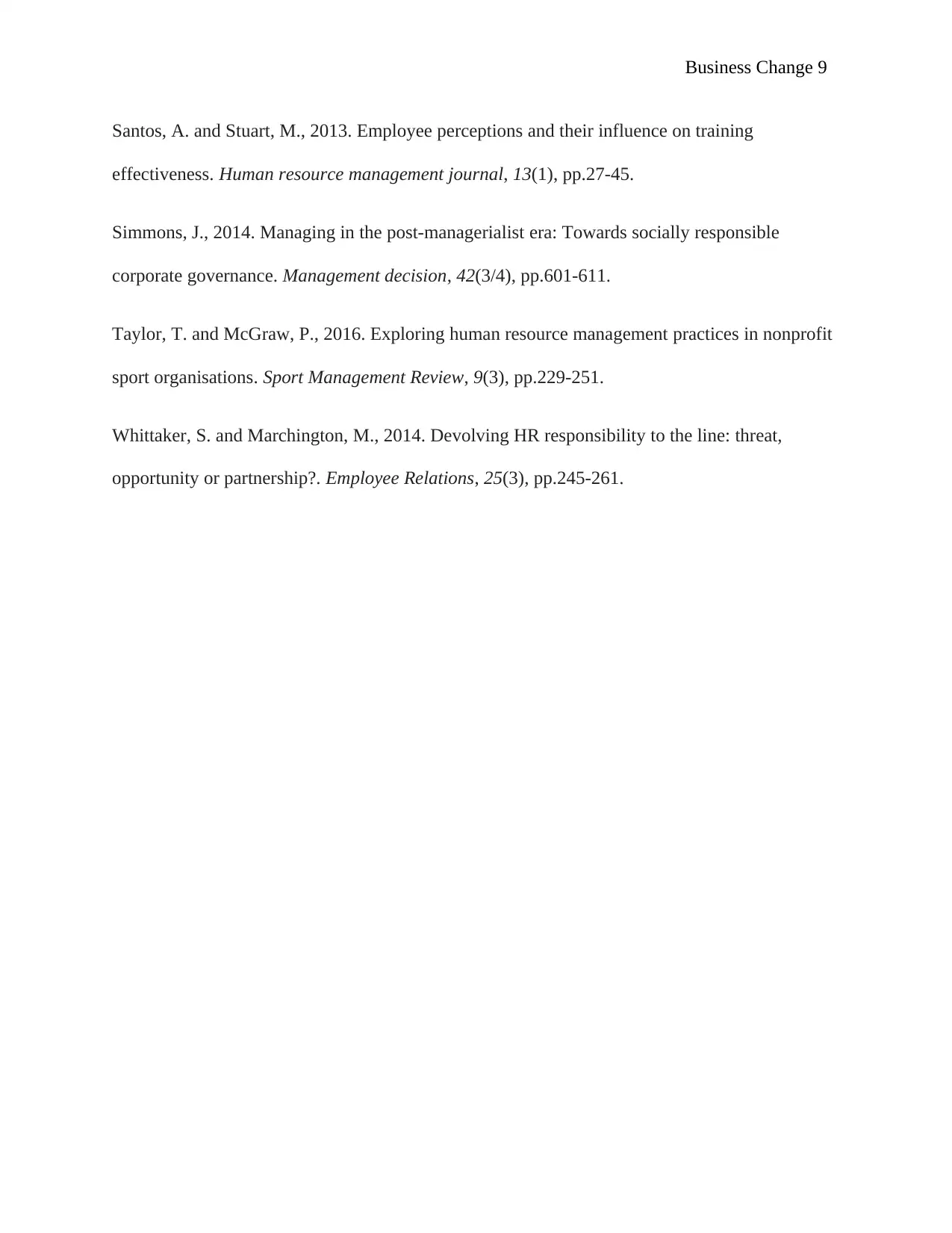
Business Change 9
Santos, A. and Stuart, M., 2013. Employee perceptions and their influence on training
effectiveness. Human resource management journal, 13(1), pp.27-45.
Simmons, J., 2014. Managing in the post-managerialist era: Towards socially responsible
corporate governance. Management decision, 42(3/4), pp.601-611.
Taylor, T. and McGraw, P., 2016. Exploring human resource management practices in nonprofit
sport organisations. Sport Management Review, 9(3), pp.229-251.
Whittaker, S. and Marchington, M., 2014. Devolving HR responsibility to the line: threat,
opportunity or partnership?. Employee Relations, 25(3), pp.245-261.
Santos, A. and Stuart, M., 2013. Employee perceptions and their influence on training
effectiveness. Human resource management journal, 13(1), pp.27-45.
Simmons, J., 2014. Managing in the post-managerialist era: Towards socially responsible
corporate governance. Management decision, 42(3/4), pp.601-611.
Taylor, T. and McGraw, P., 2016. Exploring human resource management practices in nonprofit
sport organisations. Sport Management Review, 9(3), pp.229-251.
Whittaker, S. and Marchington, M., 2014. Devolving HR responsibility to the line: threat,
opportunity or partnership?. Employee Relations, 25(3), pp.245-261.
⊘ This is a preview!⊘
Do you want full access?
Subscribe today to unlock all pages.

Trusted by 1+ million students worldwide
1 out of 9
Related Documents
Your All-in-One AI-Powered Toolkit for Academic Success.
+13062052269
info@desklib.com
Available 24*7 on WhatsApp / Email
![[object Object]](/_next/static/media/star-bottom.7253800d.svg)
Unlock your academic potential
Copyright © 2020–2025 A2Z Services. All Rights Reserved. Developed and managed by ZUCOL.





